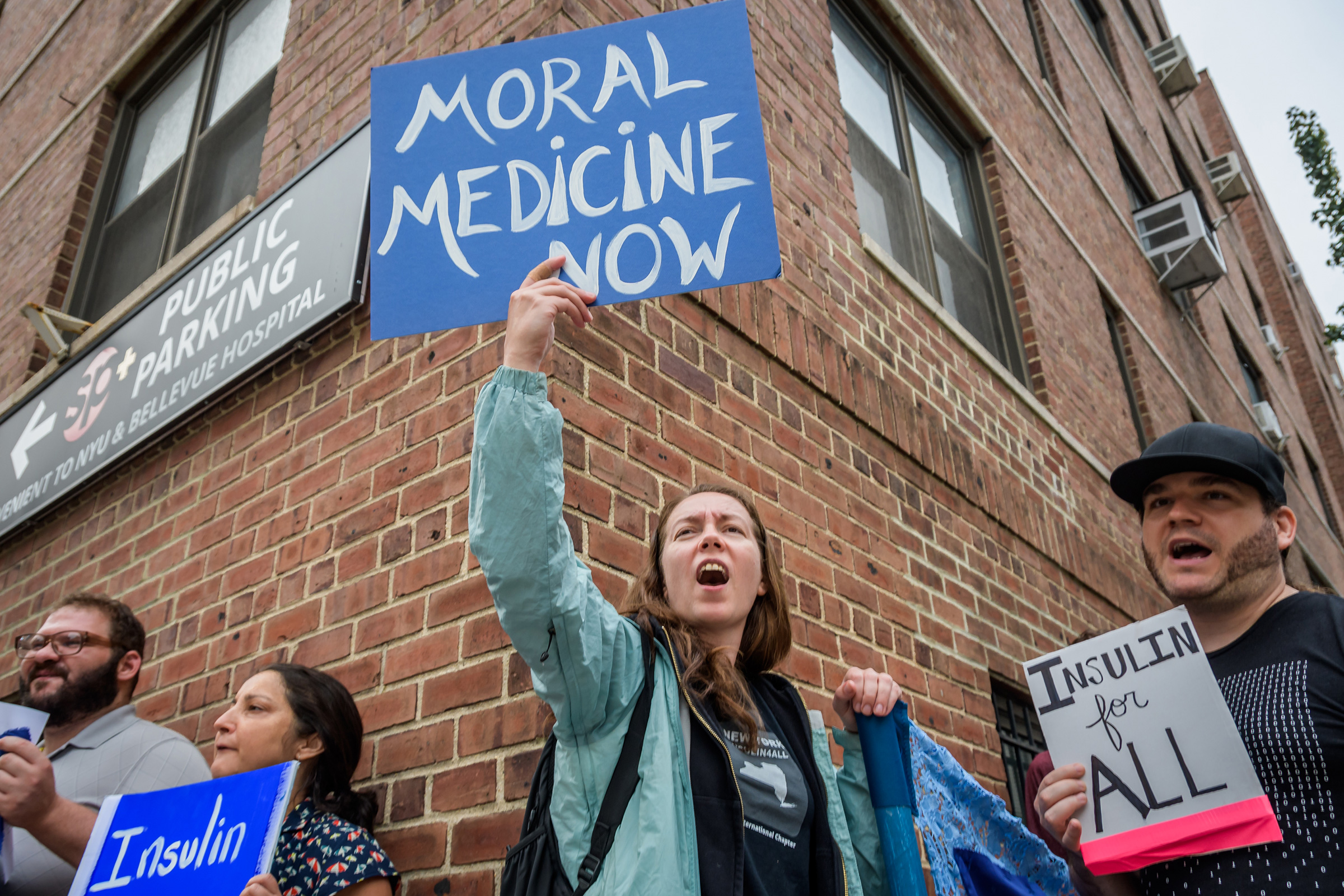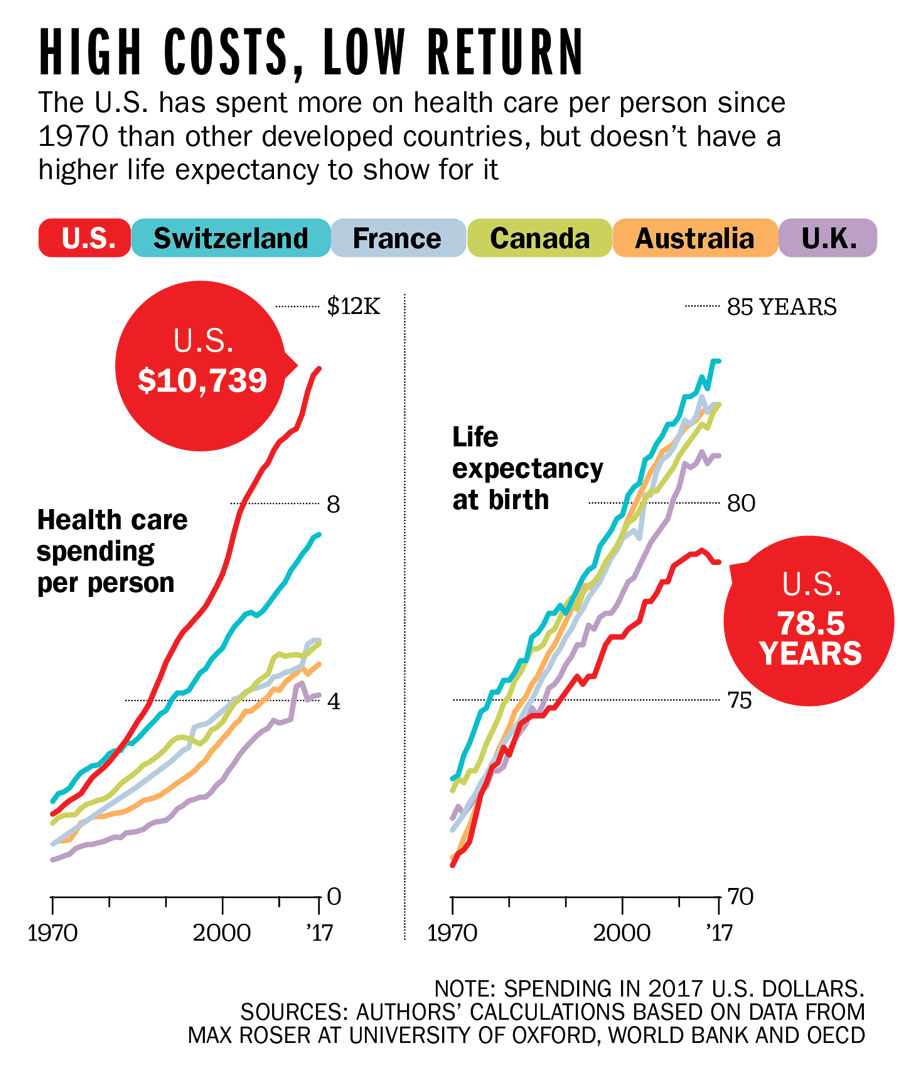
Americans spend vast sums on health care. Certainly, health care is expensive all over the world, and it makes good sense for rich countries to spend large amounts to extend their citizens’ lives and to reduce pain and suffering. But America does this about as badly as it is possible to imagine.
Health care can sometimes harm people, through medical mistakes, or the overprescription of opioids. But there is also harm to people’s lives from its extraordinary and unnecessary costs. The percentage of national income that is absorbed by health care has grown over the past half-century, from 5% in 1960 to 18% in 2017, reducing what is available for anything else from 95% in 1960 to 82% today. The costs of health care contribute to the long-term stagnation in wages; to fewer good jobs, especially for less educated workers; and to rising income inequality.
The U.S. health care system spent $10,739 per person in 2017, about five times what the country spends on defense and about three times what it spends on education. High costs inflate the earnings of many providers and make the industry unnecessarily large. The cost of employer-provided health insurance, largely invisible to employees, not only holds down wages but also destroys jobs, especially for less skilled workers, and replaces good jobs with worse jobs at lower wages. Health care costs directly hurt those without insurance, while those who are insured must pay co-payments, deductibles and employee contributions. Health costs also affect federal and state governments, which pay for Medicare and Medicaid. Governments must collect more taxes; provide less of something else, such as infrastructure or public education; or run deficits that shift the burden to future taxpayers. We could cut back costs by at least a third without compromising our health.
American health care is the most expensive in the world, and yet American health is among the worst among rich countries. The chart accompanying this story shows life expectancy and health expenditure per capita from 1970 to 2017. It highlights just how far off course the U.S. has drifted.
The U.S. has lower life expectancy than the other wealthy countries but vastly higher expenditures per person. In 1970, the countries were not very far apart, with American life expectancy not much worse and expenditures not much higher, but other countries have seen faster improvements in health and slower increases in costs. In 2017, the Swiss lived 5.1 years longer than Americans but spent 30% less per person; other countries achieved a similar length of life for still fewer health dollars. If a fairy godmother were to reduce the share of health care in American GDP to Switzerland’s, 5.6% of our GDP (or more than a trillion dollars) would be available for other things. That is more than $3,000 a year for each person in the U.S., or about $8,300 per household. If each household had been given an additional $8,300 in 2017, median income growth over the past 30 years would have been double what it actually was. These very large numbers are just the waste of health care.
America is a rich country, and it makes sense for Americans to pay for more and better health care. Yet Americans do not use more of most medical services compared with other countries’ citizens. Americans do seem to have a more luxurious system—business rather than coach, as it were—but as with business and coach passengers, everyone reaches their destination at the same time.

How is it possible that Americans pay so much and get so little? The money is certainly going somewhere. What is waste to a patient is income to a provider. The industry is not very good at promoting health, but it excels at promoting wealth among health care providers, including some successful private physicians who operate profitable practices. Physicians are the largest single occupation among the top 1% of incomes. The industry also delivers vast sums to the owners and executives of pharmaceutical companies, to medical-device manufacturers, to insurers and to large, ever more monopolistic hospitals. Much of the difference in costs compared with those of other countries comes from vastly higher prices. American doctors get paid almost twice as much as the average doctor in other wealthy countries. The effect on costs is limited because the U.S. also has fewer doctors per capita—physician-led groups have been effective in holding salaries up by holding down the number of places in medical schools, and by excluding well-qualified foreign doctors.
In a private health-insurance system like that in the U.S., insurance companies, doctors’ offices and hospitals spend huge sums on administration. In a single-payer system, more than half of these costs would be eliminated. Last, consolidation of hospitals reduces competition and raises the prices that insurers pay to cover patients; hospitals are more profitable and patients pay more for their health care.
Half of all non-elderly Americans (about 158 million people) have health insurance through an employer. Employer-provided insurance is typically well liked by those who are covered, although it is not without costs for the employee. On average, employees in 2017 paid about $1,200 (18%) of the cost of an individual policy, or $5,700 (29%) of a family policy. They also pay health-related taxes, and they have to meet co-payments at the time of treatment, as well as deductibles.
Many employees think employer contributions—the other 71% of the (average) $20,000 family policy—are free to them. Yet they are not free to the firm, and they affect how much firms are prepared to pay in wages and how many workers they employ. For an employer, it is not the wage that matters but rather what the firm has to pay to hire the worker, including the costs of health insurance and other benefits. Employees may think they are being given a gift, little realizing that what their employers care about is the total they pay, not to whom they pay it. The employee “gift” is being deducted, partially or fully, from wages. Worse still, employers faced with large increases in health premiums may eliminate jobs or outsource work to firms that pay less and provide fewer benefits.
Insurance works only when sick and healthy people are pooled together, in America by employment, and in other rich countries by government fiat across the whole population. Without subsidies for those with low incomes, and without some guarantee that everyone is always in the system, insurance cannot work. Leaving health care to the market leaves many uninsured.
Americans like to believe that their system is a free-market one, in spite of the fact that the government is paying half of the cost, is paying the prices demanded by pharmaceutical companies without negotiation, is permitting professional associations to restrict supply, and is subsidizing employer-provided health care through the tax system.
The historical accident of employer-based coverage is a huge barrier to reform. So is the way that the health care industry is protected in Washington by its lobbyists—five for every member of Congress. Our government is complicit in an extortion that is an important contributor to income inequality in America today. Through pharma companies that get rich by addicting people, and through excessive costs that lower wages and eliminate good jobs, the industry that is supposed to improve our health is undermining it.
This essay is adapted from their new book, Deaths of Despair and the Future of Capitalism. Copyright © 2020 by Princeton University Press
This article is part of a special project about equality in America today. Read more about The March, TIME’s virtual reality re-creation of the 1963 March on Washington and sign up for TIME’s history newsletter for updates.
More Must-Reads from TIME
- Why Biden Dropped Out
- Ukraine’s Plan to Survive Trump
- The Rise of a New Kind of Parenting Guru
- The Chaos and Commotion of the RNC in Photos
- Why We All Have a Stake in Twisters’ Success
- 8 Eating Habits That Actually Improve Your Sleep
- Welcome to the Noah Lyles Olympics
- Get Our Paris Olympics Newsletter in Your Inbox
Contact us at letters@time.com